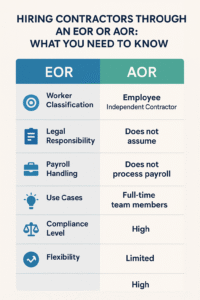
Introduction: The Art of Writing a Great Recommendation Letter
If you’re an employer, manager, or HR professional, writing a letter of recommendation is a chance to support your people and showcase your organization’s talent. Whether an employee is moving on to a new opportunity, applying for a promotion, or even pursuing further education, a well-crafted recommendation letter from you can make a real difference in their success. In a way, your letter serves as an official stamp of approval on that individual. It’s not just about them – it also reflects on your company’s values and professionalism. A lukewarm or poorly written letter could inadvertently cast doubt, whereas a strong, positive letter will highlight the candidate and speak well of your organization by extension.
Writing an effective recommendation letter requires balancing professional courtesy with genuine enthusiasm. You want to be honest and credible, but also unabashedly positive about the person you’re recommending (assuming you truly believe in them). Many letter writers struggle with what to say to avoid sounding cliche. The good news is, there are clear guidelines and best practices that can help you structure your thoughts. In this section, we’ll break down exactly how to write a compelling recommendation letter for an employee or colleague, step by step. From gathering the right information to polishing the final draft, we’ve got you covered.
Before You Begin: Gather Information and Set the Stage
1. Confirm you’re the right person to write the letter. If you don’t know the candidate’s work well or can’t provide a strongly positive review, it’s better to decline the request politely. A half-hearted recommendation can do more harm than good. It’s perfectly acceptable to say, “I don’t feel I’m the best person to write this for you,” if you’re not in a position to rave about them. This gives the individual time to find an alternate referee who can fully endorse them.
2. Get the details from the candidate. If you’ve agreed to write the letter, ask the person for any info that can help you tailor it. Ideally, have a conversation or ask them to email you their current resume, a brief description of the opportunity they’re pursuing (job posting or program details), and any specific achievements or qualities they’d love you to highlight. The best letters are specific and targeted. Knowing the context – is this for a new job, an internal promotion, an MBA program? – will guide your tone and content. Also clarify logistics: when is the letter due? Does it need to be on letterhead, or submitted through a portal, or handed to the candidate in a sealed envelope? Make sure you know the format and submission instructions upfront.
3. Reflect on your experiences with the candidate. Jot down a few standout moments or projects you worked on together. Think about their strengths: were they an excellent team leader, a technical expert, a creative problem-solver? Also consider their character and soft skills: reliable, proactive, great with clients, etc. If you have access to their performance reviews or any metrics of their work (sales figures, project outcomes), gather those too. Concrete details will make your letter credible and memorable.
4. Use your company letterhead. This is a professional correspondence, so plan to format it like a formal business letter. If you’re a manager writing on behalf of your company, using official letterhead (or at least your organization’s logo in the header) lends authenticity. It also provides the reader with your contact info readily. If you’re an HR representative, you might even have a template for reference letters – but ensure the content is personalized.
How to Structure and Write the Recommendation Letter
Writing the letter becomes easier once you have a clear structure. Most recommendation letters (for jobs) follow a similar format and should include certain key elements. Here’s a proven structure to guide you:
- Opening Greeting & Your Intent: Start with a formal salutation. If you know the name of the hiring manager or committee, address them (e.g., “Dear Hiring Committee,” or “Dear Mr. Smith,”). If not, “To Whom It May Concern,” is standard. In the first sentence, state your intent – that you are recommending [Candidate Name] for [the position or program]. Example: “I am delighted to recommend Jane Doe for the position of Marketing Analyst at XYZ Corp.”
- Introduce Yourself and Your Relationship: In the first paragraph, introduce yourself and explain your relationship to the candidate. This establishes your credibility. Mention your title and company, and how long and in what capacity you’ve worked with the person. For instance: “I am the Sales Director at Acme Inc. and I was John’s direct supervisor for three years (2019–2022) in the sales department.” This context answers the reader’s unspoken question: Why should I trust your opinion? Make it clear you know the candidate well and are qualified to assess their performanceinsightglobal.com.
- Overview of the Candidate’s Strengths: The next one or two paragraphs form the core of the letter. Highlight 2–3 of the candidate’s strongest qualifications or character traits that are relevant to the opportunity. Each point should be backed up with a specific example or story if possible. For example, if you want to praise their leadership, you might write about how they led a project to successful completion under a tight deadline, or mentored new team members. If discussing technical skills, mention a project where those skills were evident. The goal is to show, not just tell. Instead of simply saying “She’s a great team player,” you could say, “She collaborated with five different departments to implement a new software system, facilitating smooth communication and resolving conflicts effectively.” Concrete anecdotes and, if applicable, quantitative results (numbers, percentages, improvements) can really strengthen your recommendation. For instance: “Under Maria’s coordination, our team’s product launch was delivered 2 weeks ahead of schedule and 10% under budget.” These specifics make the praise more believable and useful.
- Personal Attributes and Team/Culture Contributions: A great letter doesn’t just focus on output; it also speaks to what the person is like as a colleague. Take a moment to comment on their character and soft skills – perhaps their work ethic, attitude, or how they contributed to the company culture. Did they have a great attitude that lifted team morale? Were they the go-to person for problem-solving? This personal touch can differentiate your letter. For example: “Beyond John’s impressive technical skills, I appreciated his positive attitude and integrity. He was the first to volunteer help to teammates and consistently went above and beyond to ensure team success.” Such statements convey that the candidate wasn’t just good at the job, but was also a valued member of the workplace.
- Closing Endorsement: In your closing paragraph, reiterate your strong recommendation. You might say something like, “In summary, I can enthusiastically recommend Alex for this position – he would be an asset to any organization. I have no doubt he will thrive in his next endeavor.” It’s good to literally use positive, unambiguous words like “recommend without reservation” or “highly recommend” so the message is clear. Also, offer to be available for further discussion: “Please feel free to contact me at [phone/email] if you require any additional information.” End with a formal closing (“Sincerely,” or “Best regards,”), and your signature (if printed) or typed name and title.
Following this structure will ensure your letter touches all the important bases. Now let’s look at some best practice tips to make your recommendation letter as effective as possible.
Figure: A clear structure helps you include all essential components of a recommendation letter. Start by stating who you are and your relationship to the candidate, then highlight their key strengths with specific examples, and conclude with a strong endorsement and your contact information.
Best Practices for Writing an Effective Recommendation Letter
- Be Positive and Unreserved: This is crucial. Only write the letter if you can honestly praise the person without any major reservations. Employers reading the letter will read between the lines. Even a faint or formulaic compliment (“X is a decent employee”) can be a red flag. Use an enthusiastic tone and make it clear you strongly endorse the candidate. If there are minor shortcomings, it’s usually best not to mention them at all. Focus on strengths and contributions. Your goal is to help this person advance, so cast them in the best possible light grounded in truth.
- Use a Professional Format and Tone: Recommendation letters should generally be in a standard business letter format. That means proper salutation, paragraphs, and a formal closing with your name and contact details. Write on company letterhead if available, as noted. Maintain a professional tone – warm but not overly casual. Since this letter might be read by hiring managers or admissions officers, you want to reflect the professional relationship. Aim for about one page in length (roughly 3–5 paragraphs). It’s fine if it spills slightly over one page, but typically no more than two pagesindeed.com. Busy readers appreciate conciseness.
- Tailor the Letter to the Role or Program: A generic letter is better than no letter, but a tailored letter is far superior. Try to customize your content to match the opportunity the person is pursuing. For example, if you’re recommending an employee for a managerial role and you know leadership is a key qualification, focus on examples that demonstrate their leadership. Mention the role or field by name (e.g., “role as a project manager” or “admission to MBA program”) so the reader sees the relevance. This shows that the letter isn’t just a form letter – it’s crafted for this specific use. It’s perfectly okay to ask the candidate, “What skills or qualities would you like me to emphasize for this?” – they often know what the employer or school values most.
- Include Specific Examples and, if possible, Data: We touched on this in the structure, but it’s worth reiterating. Specificity wins. Concrete examples lend credibility and help the candidate stand out. Wherever you can, mention outcomes: did they improve something by X%? Did they lead a team of Y people? Did they win any awards or exceed a target? Even a short anecdote – “I recall when our department had an unexpected crisis, and Alice stepped up to reorganize the workflow overnight, which kept our project on track” – can be golden. Numbers catch the eye, and stories stick in the mind. Specific details also prevent you from falling into empty platitudes.
- Highlight Both Hard and Soft Skills: A great employee is well-rounded, so try to comment on multiple facets. Hard skills are the technical abilities or domain knowledge (e.g., “expert in C++ programming,” “outstanding legal researcher,” “skilled in data analysis and Excel modeling”). Soft skills are just as important – teamwork, communication, adaptability, problem-solving, leadership, etc.insightglobal.com. If the person has notable personal qualities (e.g., “a calm and upbeat presence even under pressure”), mention those too. Many employers hire for attitude and potential, not just past achievements, so your insights into the person’s character can carry weight.
- Mind Your Language (Avoid Vague or Negative Tone): Write in clear, strong language. Avoid phrases that could be interpreted negatively or as lukewarm. For instance, saying “X was adequate in her role” or “did an okay job” will hurt more than help. Even something like “with more experience, Y will become an excellent engineer” might be seen as implying they’re not good enough yet. If you find you can’t avoid such phrasing, reconsider writing the letter. Also, avoid too much flowery language or exaggeration that could undermine credibility. Being honestly enthusiastic is the target tone.
- Follow Submission Instructions Exactly: This bears repeating – ensure you comply with any instructions for the letter’s format or delivery. If the company asks for the letter to be emailed to HR, do that; if they have an online form, use it. Sometimes, you might need to hand the sealed envelope to the candidate to include in their application. Little things like file format (PDF vs. Word) or naming conventions can matter. Doing this right reflects well on the candidate and on you as a detail-oriented professional.
- Proofread and Edit: A recommendation letter is a reflection of your own professionalism, so take the time to proofread carefully. Check for any spelling errors (especially the candidate’s name and the company/program name!), grammatical mistakes, and clarity of sentences. Reading the letter aloud can help catch errors or awkward phrasingindeed.com. If appropriate, have another colleague read it to see if it hits the right notes. Ensure the tone remains positive and that the letter is coherent and well-organized. Sloppy or error-laden letters can inadvertently cast doubt on the content – you don’t want a hiring manager thinking the candidate chose a careless recommender.
By following these best practices, you’ll produce a letter that truly supports your former employee or colleague. Not only will you be helping them out, but you’ll also demonstrate the integrity and supportive culture of your company. A thoughtfully written recommendation can leave a lasting positive impression about both the candidate and your organization.
Frequently Asked Questions (FAQs) for Employers Writing Recommendation Letters
Q1: What if I’m too busy to write a detailed letter? Can I just give a quick reference call instead?
A: If you’re genuinely pressed for time, it’s understandable – but consider the impact a letter can have. Often, former employees request a letter because the application requires or favors it. If you absolutely cannot write it, be honest with the person; perhaps someone else in the organization could step in. However, a well-crafted letter doesn’t have to be very long. Even a concise 3-paragraph letter highlighting key points is better than no letter. Another approach: you could ask the candidate to draft something for you to edit. Some are willing to do this, and it ensures the letter covers what they need (just be sure to review and personalize it so it’s authentic). In general, try to accommodate the request if at all possible – it’s an important professional courtesy that people remember. And as an employer, supporting your alumni can boost your reputation.
Q2: Is it okay to reuse a reference letter I wrote for someone else and just change the name?
A: It might save time, but it’s not recommended. Each person’s strengths and context are different, and a recycled letter can come off as generic. Savvy readers can often spot a template. Moreover, you risk leaving incorrect details (like the wrong pronouns or an irrelevant example) which would look unprofessional. It’s better to use a standard structure (as we outlined above) but fill in the specifics for each individual. If you do start from a past letter, double-check every sentence to make sure it applies to the current person. In short, personalize each letter to maintain credibility and effectiveness.
Q3: Can I refuse to write a recommendation letter for an employee?
A: Yes, you can. If you feel you cannot honestly praise the individual – for example, if their performance was subpar or you had significant issues – it’s within your rights to decline. In fact, it’s more respectful to decline than to write a lukewarm or negative letterindeed.com. How to do it? Thank them for asking, and politely say you don’t think you’re the best person to write this letter. You don’t need to go into detail about reasons. If appropriate, you might offer to confirm employment or serve as a neutral reference (dates and titles only). This situation can be delicate, but remember: a generic or negative letter can seriously harm their chances, and it could reflect poorly on you/your company as well. So if you can’t be positive, it’s better to say no.
Q4: Should I mention the reason the person is leaving the company (if it’s for a new job)?
A: Generally, you don’t need to. Focus on the future role and the person’s qualities, not on why they’re moving on from their current position. However, if it’s a positive reason that supports their narrative (e.g., they’re relocating for family or pursuing growth that your company couldn’t provide), you can briefly mention it in a neutral way. For example, “While we’re sad to lose her as she relocates to another city, I genuinely believe Jane will be a tremendous asset to her next employer.” Avoid any negative or complicated explanations (like office politics, layoffs, etc.). Keep the letter forward-looking and positive. If the new role is a promotion or logical next step, you can convey excitement for their growth, which reflects well on you as supportive leadership.
Q5: Do I need to follow up after sending the letter?
A: Once you’ve sent or submitted the recommendation, your main role is done. It’s considerate to let the employee know the letter has been sent (“Just to confirm, I emailed your letter to the HR contact today. Best of luck with your application!”). You typically wouldn’t contact the hiring company unless they reach out to you for clarification. It’s nice, however, to later check in with the former employee to ask how things went. Also, be prepared that if the candidate gets the job (or admission), they might want to update you or even celebrate together. Maintaining that positive relationship can lead to great networking down the line – you never know when your paths might cross again in a professional context.
Conclusion: Writing a letter of recommendation is both an opportunity and a responsibility. By investing some effort into a well-written letter, you not only help your former employee or colleague advance in their career, but you also demonstrate the integrity and supportive culture of your organization. A strong recommendation can highlight the talent that comes from your team – think of it as a little ambassador of your company’s quality. Employers and HR professionals who consistently provide thoughtful references build goodwill and a positive reputation in their industry.
Call to Action: If you’re unsure how to start or want to ensure your recommendation letters hit the mark every time, Divino Business Solutions can assist. We offer a downloadable Recommendation Letter Template Pack for employers and HR, along with guidance on best practices in talent management. Contact us for expert HR support or download our free template pack to make writing your next letter of recommendation quick and effective. Let’s work together to champion great talent!





